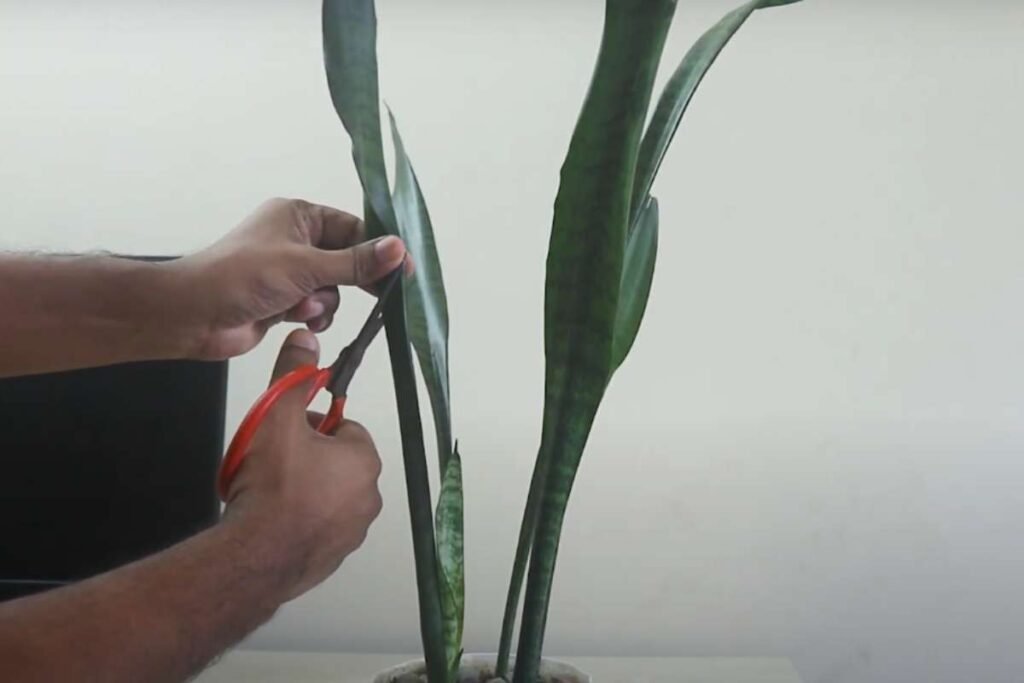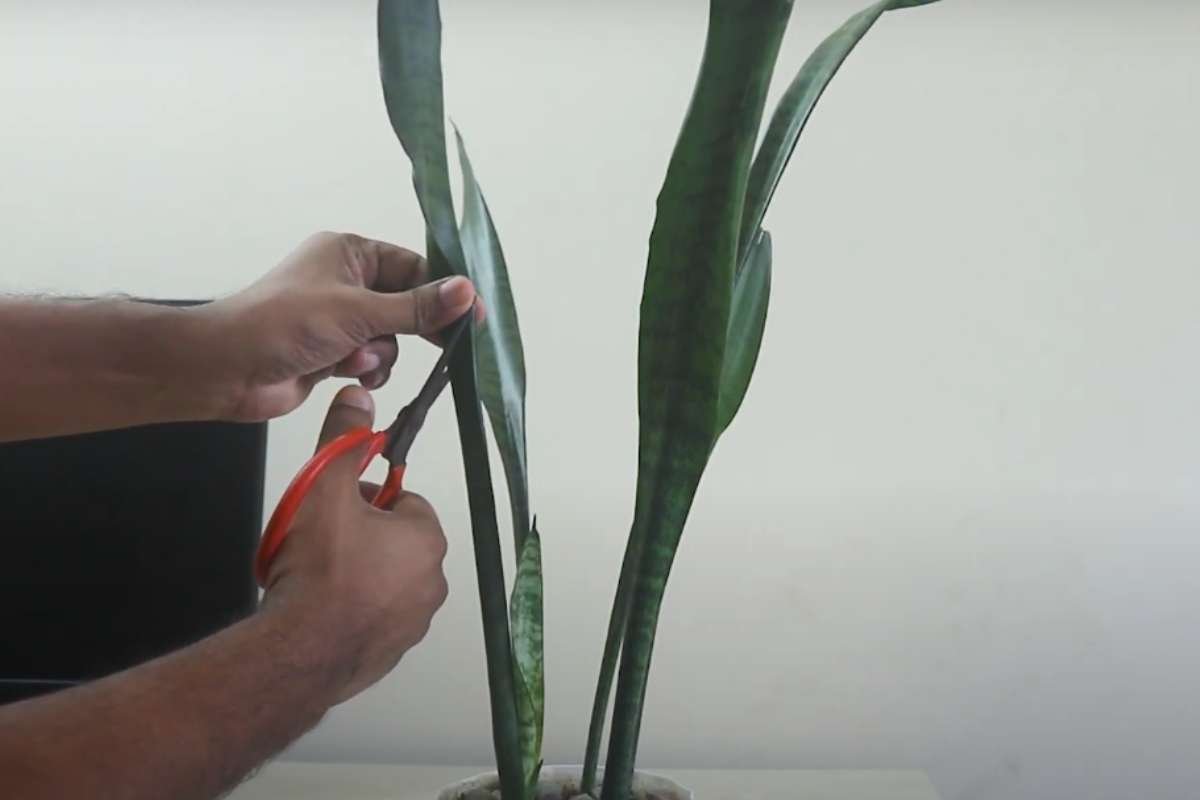Snake plants (Sansevieria), also known as mother-in-law’s tongue, are one of the most resilient and low-maintenance indoor plants.
With their stiff, upright leaves and ability to thrive in various conditions, they make a fantastic addition to homes, offices, and gardens.
One of the most crucial aspects of keeping a snake plant healthy is knowing how and when to prune it. Pruning ensures that the plant remains vibrant, prevents overcrowding, and allows it to focus its energy on new growth.
While the snake plant is often described as “indestructible,” understanding the nuances of its care—including proper pruning—can make all the difference between a healthy, thriving plant and one that merely survives.
This comprehensive guide will explore the importance of pruning, the step-by-step process, the tools you need, how to manage different issues like overgrowth, pests, and diseases, and how to propagate your snake plant for better growth.

Table of Contents
Why Pruning is Essential for Snake Plants
Pruning is essential for several reasons. Though snake plants are hardy, they benefit from regular maintenance to ensure they grow properly. Some key reasons for pruning include:
- Promotes Healthy Growth: By trimming away dead or damaged leaves, you prevent the plant from wasting resources on parts that can no longer contribute to its health.
- Prevents Overcrowding: Snake plants can produce new leaves at the base and quickly fill up a pot. Overcrowding can lead to poor airflow, making the plant more vulnerable to pests and diseases.
- Aesthetic Appeal: Pruning helps maintain the plant’s shape, making it look tidy and well-kept.
- Disease and Pest Control: Removing dead or infested leaves can prevent the spread of pests and fungal diseases.
- Encourages New Growth: When old or damaged parts are removed, the plant can focus on developing new leaves and roots.
Understanding when and how to prune is crucial in maintaining your snake plant’s vitality.
The Anatomy of a Snake Plant
Before diving into pruning techniques, it’s important to understand the plant’s anatomy. Snake plants have several structural components that determine their growth patterns:
- Leaves: Snake plants feature tall, sword-like leaves that can range from deep green to variegated shades of green, yellow, or white. The leaves grow directly from the plant’s root system in a rosette pattern.
- Rhizomes: These are underground stems from which the leaves grow. Rhizomes spread horizontally and can produce new leaves and roots, making them essential for propagation.
- Roots: The roots are fibrous and spread horizontally, supporting the plant as it grows.
Knowing these parts will help you determine where to prune and how to avoid damaging the plant’s growth system.
Tools You Need for Pruning
Having the right tools ensures clean cuts and prevents damage to the plant. Here’s a list of essential tools you’ll need:
- Sharp Pruning Shears or Scissors: Always ensure they are clean and sharp to avoid tearing the leaves, which could invite disease.
- Rubbing Alcohol or Disinfectant: To sterilize your tools before and after pruning to prevent spreading diseases.
- Gloves: Snake plants can cause mild skin irritation, so wearing gloves is recommended, especially if you have sensitive skin.
- A Towel or Cloth: To clean any sap or moisture from the leaves after cutting.
- A Small Pot or Container: For propagating any healthy leaves you might prune.
By preparing your tools beforehand, you ensure a smooth, efficient pruning process.
When to Prune a Snake Plant
Timing is an important factor when pruning your snake plant. While the snake plant can technically be pruned at any time, there are optimal periods that will yield the best results.
- Spring or Early Summer: This is the best time for pruning, as it’s the snake plant’s active growing season. Trimming during this time encourages rapid recovery and new growth.
- When You Notice Overcrowding: Snake plants can become quite bushy when they produce multiple offshoots. If you notice that the pot is becoming too full, it’s time to prune and repot if necessary.
- Whenever You Spot Dead or Damaged Leaves: If a leaf becomes yellow, brown, or mushy due to overwatering or disease, it should be pruned immediately. Letting these leaves stay on the plant can cause more harm than good.
- After Repotting: Sometimes, after repotting, the plant may go through a period of shock. Pruning can help it refocus its energy on recovering.
Step-by-Step Pruning Process
1. Assess the Plant
Start by closely examining your snake plant. Identify leaves that are damaged, yellowing, overly long, or crowding the pot. You’ll want to focus on these areas during pruning.
2. Sterilize Your Tools
Use rubbing alcohol or another disinfectant to clean your scissors or pruning shears. This prevents any bacteria or fungal spores from transferring to the healthy parts of the plant.
3. Remove Dead or Damaged Leaves
Start by trimming off the leaves that are brown, yellow, or otherwise damaged. Cut the leaf as close to the base as possible without cutting into the rhizome. Always make clean, straight cuts to avoid tearing the plant tissue.
- For Yellow Leaves: This is often due to overwatering or a lack of light. Cut at the base to remove the entire leaf.
- For Brown Tips: Sometimes, only the tips of the leaves turn brown due to lack of humidity or irregular watering. In this case, you can trim the affected parts of the leaf, leaving the rest of the leaf intact.
4. Trim Overgrown or Crowded Leaves
Next, focus on overgrown or crowded leaves. While it may be tempting to leave them for a fuller look, too many leaves can block airflow and reduce light penetration. You can cut these leaves in the same manner as the damaged ones.
If you are trimming healthy leaves, consider saving them for propagation (more on that later).
5. Handle the Roots
If you’re repotting your snake plant at the same time as pruning, examine the roots. Healthy snake plant roots are firm and white.
If you spot any mushy, black, or rotting roots, these should be cut away using sterilized scissors. After trimming the roots, allow them to dry for a day before repotting to prevent fungal infections.
Dealing with Common Issues While Pruning
While pruning your snake plant, you might encounter some issues. Here’s how to deal with them:
1. Pests
Mealybugs and spider mites are the most common pests that attack snake plants. If you notice these pests, prune the affected leaves immediately.
Wipe the remaining leaves with a damp cloth and treat with insecticidal soap or neem oil.
2. Overwatering
Snake plants are drought-tolerant and don’t need frequent watering. Overwatering can lead to root rot, which shows up as yellowing or mushy leaves.
Prune the damaged parts, allow the soil to dry out, and adjust your watering schedule.
3. Underwatering
If you notice the leaves curling inward, it could be a sign of underwatering. While pruning is less urgent in this case, make sure to adjust your watering routine to help the plant recover.
Propagating Snake Plants Through Pruning
One of the biggest advantages of pruning your snake plant is that you can propagate new plants from healthy leaves. Here’s a simple method for leaf propagation:
1. Select a Healthy Leaf
After pruning, choose a healthy, mature leaf for propagation. Make sure the leaf is free from pests or disease.
2. Cut the Leaf into Sections
Using sterilized scissors, cut the leaf into sections about 4-6 inches long. Each section will become a new plant.
3. Dry the Cuttings
Before placing the cuttings in soil, allow them to dry for a few days. This step prevents the cuttings from rotting once they’re planted.
4. Plant the Cuttings
Once the cuttings are dry, place them in well-draining potting mix. Water them lightly, and place the pot in a warm, indirect light environment.
Over the next few weeks, the cuttings will develop roots and eventually sprout new growth.
Caring for Your Snake Plant After Pruning
After pruning, it’s important to give your snake plant a little extra attention to help it recover and thrive:
- Watering: Let the soil dry out between waterings. Overwatering after pruning can cause root rot.
- Light: Place your plant in a spot with indirect sunlight. Avoid harsh direct light, especially after pruning.
- Humidity: Snake plants prefer dry conditions, but misting the plant occasionally can help keep the leaves clean and free of dust.
- Fertilization: Snake plants don’t require heavy feeding. However, after pruning, a light application of a balanced liquid fertilizer can help stimulate new growth.
Pruning vs. Repotting: Which Should You Do First?
Sometimes, pruning and repotting go hand in hand. If your snake plant is severely overcrowded, you might consider repotting it into a larger container while pruning away old or damaged leaves.
Repotting Tips:
- Choose a pot that’s one size larger than the current one to prevent overcrowding in the future.
- Use well-draining soil, as snake plants are susceptible to root rot.
- After repotting, hold off on watering for a few days to allow the roots to settle.
Related FAQs:
How often should I prune my snake plant?
Snake plants generally don’t need frequent pruning. You should prune them when you notice dead, damaged, or yellowing leaves, or when the plant becomes overcrowded. This typically happens once or twice a year.
Can I trim just the tips of brown leaves, or should I remove the entire leaf?
If the tips of the leaves are brown, you can trim just the affected portion. However, if the leaf is significantly damaged or yellowing, it’s better to remove the whole leaf at the base.
What should I do if my snake plant is drooping after pruning?
Drooping can be a sign of stress, often from overwatering, underwatering, or sudden changes in the environment. After pruning, ensure the plant has adequate light, proper watering, and a consistent environment.
Can I propagate a snake plant after pruning?
Yes! You can propagate snake plants using healthy leaves from pruning. Let the leaf cuttings dry out for a few days and plant them in well-draining soil to encourage root development.
What is the best time of year to prune a snake plant?
The best time to prune a snake plant is during its active growing season in spring or early summer. This allows the plant to recover more quickly and promotes healthy new growth.
Is it okay to prune the roots when repotting my snake plant?
Yes, root pruning is essential if you notice overgrown, rotting, or unhealthy roots during repotting. Trim away the damaged parts, and let the roots dry for a day before replanting.
What causes my snake plant’s leaves to turn yellow?
Yellowing leaves are typically caused by overwatering, which leads to root rot. Other causes include lack of light, poor soil drainage, or pest infestations. Prune the yellow leaves and adjust the plant’s care routine.
Can pruning save a dying snake plant?
Pruning damaged or diseased parts of a dying snake plant can help it recover, especially if the underlying issue is addressed, like correcting overwatering or treating pests.
How do I know if my snake plant needs to be repotted?
A snake plant needs repotting if the pot becomes overcrowded with leaves, if roots are growing out of the drainage holes, or if the plant seems root-bound, with little space left for growth.
Do snake plants need light after pruning?
Yes, after pruning, snake plants need indirect sunlight to promote healthy recovery and new growth. Avoid placing them in harsh direct sunlight, which can stress the plant.
Conclusion
Pruning a snake plant is essential for keeping it healthy and aesthetically pleasing. Regular pruning prevents overcrowding, encourages new growth, and helps to control pests and diseases.
By following the proper techniques—assessing the plant, using the right tools, and knowing when to trim—you can keep your snake plant thriving for years to come.
Remember to pay attention to common issues like overwatering, pests, and poor light conditions, as these can affect the plant’s overall health.
If done correctly, pruning can also serve as an excellent opportunity to propagate new snake plants, expanding your collection or sharing with friends and family.
Whether you’re an experienced gardener or just starting, mastering the art of pruning a snake plant is a valuable skill that will help you maintain not only your snake plant but many other indoor plants as well.
Keep your snake plant in optimal shape by incorporating regular pruning into its care routine, and watch it flourish!
My name is Shahriar Robin, and my journey with plants began in childhood, igniting a lifelong passion that blossomed alongside my career as a nutritionist and sports trainer. Through SnakePlant.org, I channel this dedication, merging expertise from nutrition and sports training to nurture a platform sharing all-encompassing knowledge about Snake plants. This website mirrors my commitment to cultivating greenery, offering comprehensive insights on growth, maintenance, and nurturing practices for these captivating plants. My mission is rooted in leveraging diverse expertise to enhance plant care practices, believing profoundly in the therapeutic impact of nature. Join me on SnakePlant.org, where I unite a thriving community of enthusiasts, sharing experiences, insights, and the profound joys of planting.

